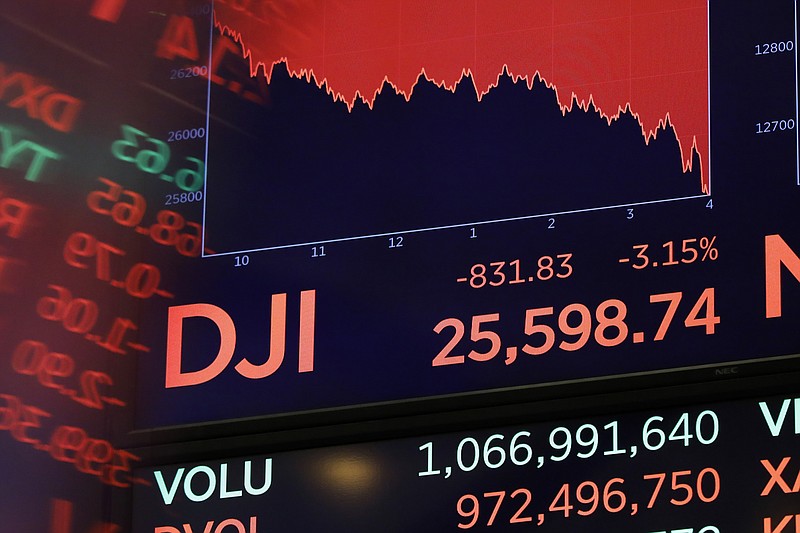NEW YORK (AP) — U.S. stocks plunged Wednesday as investors, fearful that rising interest rates and trade tensions could hurt company profits, ramped up their selling of high-flying technology and internet stocks. The Dow Jones Industrial Average fell 831 points, its worst loss in eight months.
The losses were widespread, and stocks that have been the biggest winners on the market suffered steep declines. Apple and Amazon, the two most valuable companies in the S&P 500, each had their worst day in two and a half years.
The Nasdaq composite, which has a high concentration of technology companies, sustained its biggest loss in more than two years and has dropped almost 8 percent since the start of October.
Wednesday’s drop should be placed in perspective. Since early 2009, the S&P 500 has quadrupled, driven higher by the U.S. economic expansion, hefty profits for corporations and historically low interest rates, all of which makes stocks an attractive investment.
Stocks have slumped over the last week, largely due to worries over rising interest rates. The Federal Reserve recently raised short-term interest rates for the third time this year. Strong economic data and a positive outlook from Fed officials last week sent bond yields sharply higher and sparked concerns about even higher interest rates.
Big moves in interest rates tend to unsettle investors, and they can also push them to sell stocks and buy bonds instead. And there is still an overhang from the U.S. trade dispute with China, which accounts for sizeable portions of some tech companies’ revenue.
Alec Young, managing director of global markets research at FTSE Russell, said investors fear that rising interest rates and growing expenses are going to erode the boost company profits have gotten from the GOP tax overhaul.
President Donald Trump called Wednesday’s market plunge “a correction we’ve been waiting for for a long time.”
The Dow Jones Industrial Average gave up 831.83 points, or 3.1 percent, to 25,598.74. The S&P 500 index sank 94.66 points, or 3.3 percent, to 2,785.68. The benchmark index fell for the fifth straight day, which hadn’t happened since just before the 2016 presidential election.
The Nasdaq composite, with a large contingent of tech stocks, tumbled 315.97 points, or 4.1 percent, to 7,422.05. It’s fallen 7.5 percent in just five days.
The Russell 2000 index of smaller-company stocks shed 46.45 points, or 2.9 percent, to 1,575.41.
The market had enjoyed a stretch of relative calm, where even big intraday losses were erased by the end of the day. However, over the past five days, the losses stuck, and on Wednesday the selling went on right to the closing bell.
Some of the big losers were stocks that have scored double-digits gains this year. Apple gave up 4.6 percent to $216.36 and Microsoft dropped 5.4 percent to $106.16. Amazon skidded 6.2 percent to $1,755.25 and Alphabet, Google’s parent company, gave up 4.6 percent to $1,092.16.
Amazon has soared 50 percent this year, but has fallen 14 percent from its all-time high in early September. Alphabet has dropped 15 percent since late July.
Although the yield on the 10-year Treasury declined toward the end of the day, its jump from 3.05 percent early last week to more than 3.20 percent — a seven-year high — has spooked investors. The yield was just 2.82 percent in last August.
The Federal Reserve has been gradually raising interest rates for more than two years as the U.S. economy grows. When yields rise for that reason, it is generally good for stocks. But eventually the higher rates worry stock investors, as they tend to increase borrowing costs and cut into profit margins. They also make bonds more attractive investments.
There is some concern among investors that the Fed could overreact to the strong economy — it grew at a robust annual rate of 4.2 percent in the second quarter — and ramp up rate hikes and prematurely put the brakes on growth.
Technology and internet-based companies are known for their high profit margins, and many have reported explosive growth in recent years, with corresponding gains in their stock prices.

